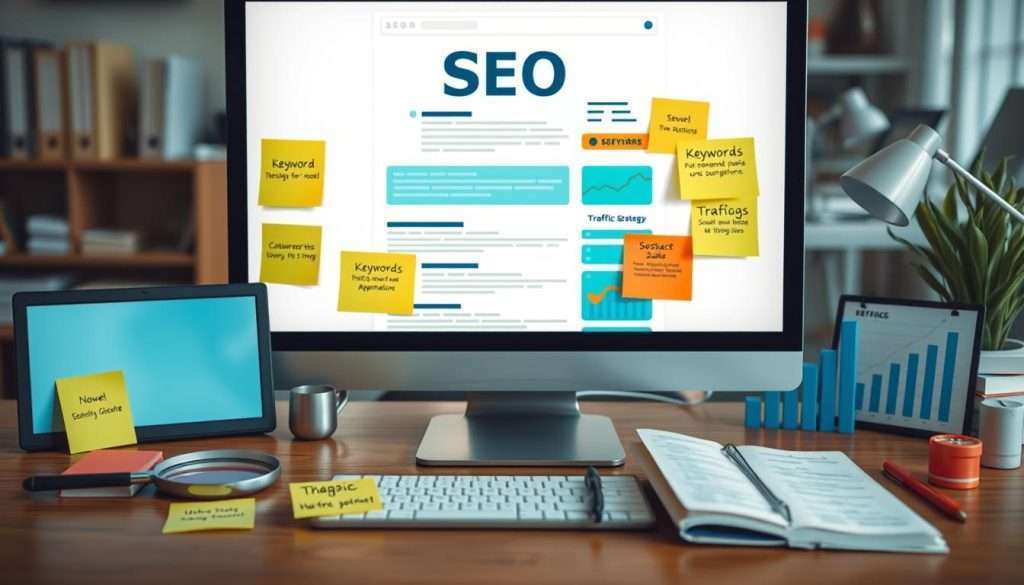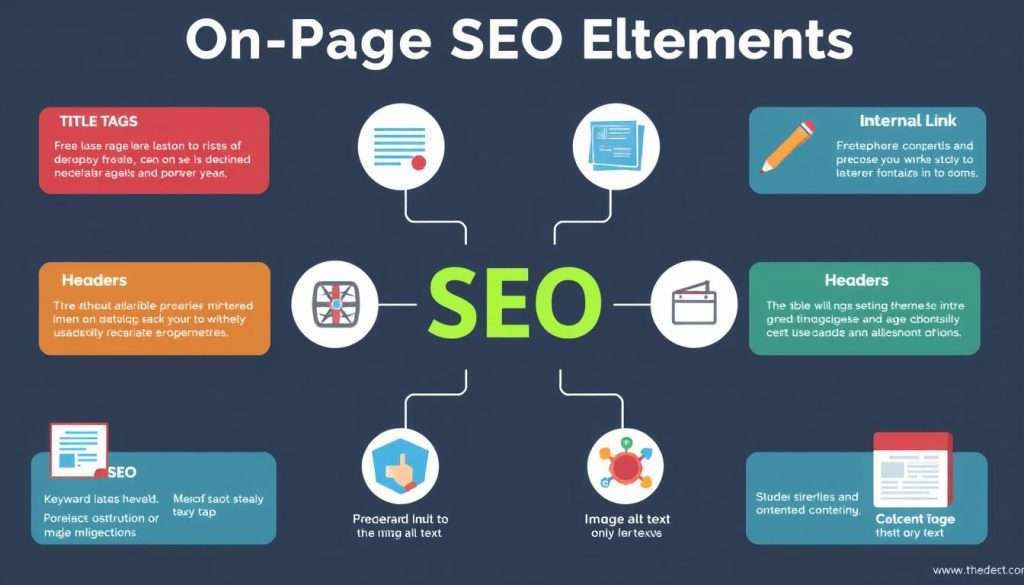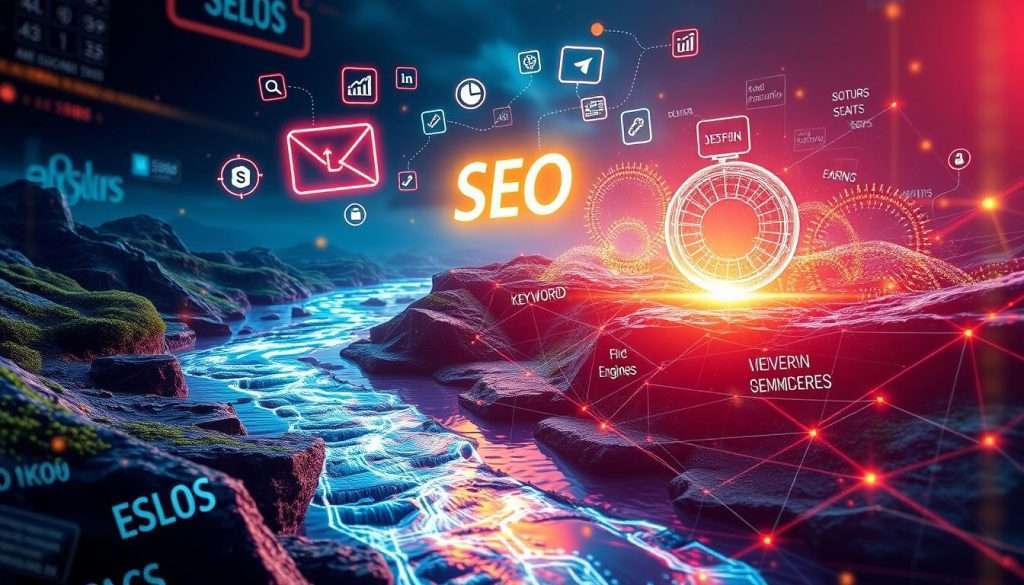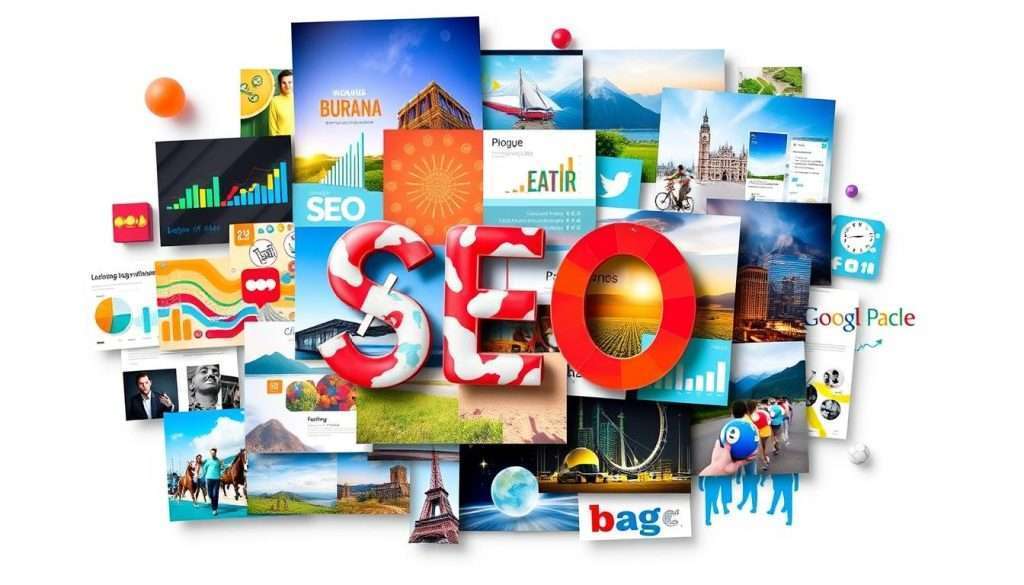Physical Address
304 North Cardinal St.
Dorchester Center, MA 02124
Physical Address
304 North Cardinal St.
Dorchester Center, MA 02124
On-page SEO makes your web pages more visible and ranked higher on search engine results. It involves many steps, like optimizing title tags and meta descriptions. It also means improving content, linking between pages, and the website’s technical side.
Unlike off-page SEO, which looks at external factors, on-page SEO focuses on your website and its content. It’s about making sure your site is great for both search engines and visitors.
In 2025 and later, on-page SEO is key for any digital marketing plan. Search engines now value user experience, search intent, and content quality more than keywords. By learning about on-page optimization, you can help your website succeed in the changing world of SEO.

On-page SEO and off-page SEO are key parts of SEO. Off-page SEO looks at things like backlinks and social media. On-page SEO aims to optimize your website to improve its visibility on search engines.
On-page SEO is about things you can control on your website. This includes content, meta tags, and technical stuff. Off-page SEO is about things outside your control, like links and social media.
In 2025, on-page SEO is still very important. It helps search engines understand your website better. By improving your website, you can make it more user-friendly and relevant.
The main parts of on-page SEO are:
By focusing on these areas, you can talk better to search engines and improve your website. This improves your website’s ranking and draws more visitors.
On-page SEO, also known as on-site SEO, is about making web pages better for search engines and users. Optimizing a website involves enhancing its content and technical elements to improve functionality and visibility. This way, website owners can better communicate with search engines and users.
The main parts of on-page SEO include:
By working on these on-page SEO elements, website owners can show search engines that their content is relevant and trustworthy.This results in improved rankings and increased organic traffic, which can translate into more potential customers and higher sales for a business.
| On-Page SEO Element | Importance for Website Optimization |
|---|---|
| Content Quality and Relevance | High-quality, informative, and keyword-focused content is essential for satisfying user intent and demonstrating expertise, authoritativeness, and trustworthiness (E-A-T) to search engines. |
| HTML Tag Optimization | Optimizing elements like title tags, meta descriptions, headers, and alt text helps search engines better understand the content and context of a page, leading to improved visibility in search results. |
| Site Structure and Internal Linking | A well-organized site architecture and strategic internal linking improve website crawlability and user experience, which are important ranking factors for search engines. |
| Technical Optimization | Factors like site speed, mobile-friendliness, and structured data implementation contribute to a positive user experience and enhanced search engine visibility. |
By focusing on these core on-page SEO elements, website owners can significantly improve their online visibility, drive more qualified traffic, and ultimately, achieve their business goals.

The title tag is key for on-page SEO, giving a quick summary of a webpage’s content. Making your title tags better can really help your search rankings and get more clicks. Here are the top tips for writing titles that are good for SEO:
Adding words like “best,” “guide,” or “review” can make your title stand out. It also provides users with a clearer understanding of what they can expect. Using power words that spark interest or emotion can also boost click-through rates.
The best title tag length is 50 to 60 characters. This ensures your title shows fully in search results. Don’t go over 60 characters, as Google might cut it off. Also, remember the pixel width limit, as Google has a specific limit for title tag display.
By following these tips for optimizing title tags, you can make titles that are good for SEO. This helps both search engines and users quickly get what your webpages are about. It leads to better visibility and more engagement.
Meta descriptions are key for getting more clicks from search results. They make your web pages stand out and attract more visitors. This can result in a larger audience discovering your website.
Here are some tips to make your meta descriptions work better:
By using these strategies, you can make your web pages more visible and appealing in search results. This can lead to more targeted traffic and better search engine rankings.

An engaging meta description can significantly influence potential customers and encourage them to visit your website.”
Optimizing content is key to on-page SEO. It affects search rankings and how users experience your site. Good content optimization means using keyword placement wisely, making your content readable and structured, and focusing on user experience.
Using relevant keywords in your content is crucial. But do it naturally and without overdoing it. Aim for a keyword density that’s just right, not too much. Use keywords in headings, the first paragraphs, and throughout your content.
Ensure your content is well-organized and easy to understand. Use heading tags (H1, H2, H3) to organize it. Add bullet points, short paragraphs, and images to make it more engaging.
User experience is crucial in on-page SEO. Your content should be interesting, helpful, and valuable to your audience. Think about what your buyers need and address their concerns. Enhance your content by incorporating visuals such as images and videos.
By using these techniques, you can boost your site’s visibility, attract more users, and be seen as a reliable source in your field.
Optimizing images on your website is key for on-page SEO. It boosts user engagement, speeds up your site, and helps it show up in image searches.
Using descriptive, keyword-rich alt text is crucial. Alt text supports search engines in understanding images and aids visually impaired users. It should be 10-15 words that describe the image well and include keywords.
Image file names should also be meaningful and include keywords. This helps search engines understand your images better. Also, compressing images without losing quality can make your site load faster. This is good for search rankings and user experience.
Visual content can draw in your audience and drive traffic. With good image optimization, your visuals will help your SEO and online success.

“Image optimization improves the user experience on your site, making it more efficient and visually appealing. This increases your visual content’s visibility and helps your on-page SEO.
Internal linking is key to on-page SEO. It’s the foundation of your website’s structure and navigation. By linking your pages, you boost user experience and help search engines understand your site.
The anchor text of internal links is crucial. It assists search engines in comprehending the content of the linked page. To make your anchor text more effective, follow these guidelines:
A well-structured site architecture is vital for internal linking. It makes your content easy for users and search engines to find. Here are some strategies to consider:
Placing internal links strategically can boost your SEO. Here are some methods to try:
| Link Type | Purpose |
|---|---|
| Contextual Links | Embed internal links within your content to guide users to relevant information. |
| Navigational Links | Use menu structures, breadcrumbs, and other navigational elements to help users and search engines understand your site’s hierarchy. |
| Footer Links | Include internal links in your website’s footer to provide additional navigation options. |
With a solid internal linking strategy, you can enhance your website’s SEO and offer a better user experience.
Improving your website’s technical parts is key to getting noticed by search engines. Using structured data markup makes it easier for search engines to comprehend your content. This can make your search results look more appealing and increase clicks.
Page speed is also crucial. Websites that load fast are better for users and search rankings. Search engines favor quick websites because they know users like fast content. Use tools like Google’s PageSpeed Insights and Mobile-Friendly Test to find ways to speed up your site.
Having a good URL structure, making sure your site works on mobile, and using HTTPS are also important. These help make your site easy to use and search engine friendly. This can improve your visibility and rankings in the technical SEO world.
Improving the technical elements of your website is a vital part of gaining strong visibility and higher rankings on search engines.
By focusing on technical SEO like page speed and structured data, you can make your site more visible and engaging. Regular checks can help you fix any problems and keep your SEO in top shape.

In today’s world, making sure your website works well on small screens and loads fast is key. Google now looks at your site’s mobile-friendly design and page load time when ranking it. This plays a key role in enhancing user experience while boosting search engine rankings.
Responsive design is a must, making your site work well on all devices. But it’s not enough. Your site also needs to load quickly, keeping users interested.
Studies reveal that 53% of mobile users exit a site if it loads too slowly. Even a one-second delay can decrease conversions by up to 7%. Google recommends pages load within 3 seconds, targeting less than 1.3 seconds for the first byte.
To meet these goals, use tools like Google’s PageSpeed Insights to find and fix speed issues. Think about implementing Accelerated Mobile Pages (AMP) to enhance loading speed. Also, optimize images, minify code, enable caching, and reduce render-blocking resources to make your mobile site fast.
Remember, mobile optimization and page speed are crucial today. They help meet user needs and improve search rankings. A fast, responsive, and mobile-first website offers a great user experience and keeps search engines happy.
| Key Metrics | Recommended Targets |
|---|---|
| Page Load Time | Less than 3 seconds |
| Time to First Byte | Less than 1.3 seconds |
| Round Trip Requests | Fewer than 50 per page |
| Total Page Size | Less than 500 KB |
| Pieces of Content | Fewer than 50 |
On-page SEO is key in 2025. It covers many areas, like content and technical setup. To succeed, you need to think about both user needs and search engine rules.
Keeping up with updates and following best practices is vital. As search algorithms change, knowing the latest trends is important. By focusing on things like title tags and content, businesses can grow online.
Using good on-page SEO, along with a strong off-page presence, helps you stand out. Companies that focus on on-page optimization can attract more customers. They can also build a strong presence in their field.
On-page SEO makes your web pages better for search engines and more relevant to users. It involves optimizing content, HTML tags, images, and ensuring your site is trustworthy (E-A-T).
On-page SEO focuses on your website itself. Off-page SEO looks at external factors. In 2025, on-page SEO is still key for better user experience and search engine rankings.
On-page SEO is still vital in 2025. Google uses traditional factors like keywords but also values user experience and mobile optimization.
Key components include keyword optimization, meta tags, and schema markup. Also, internal linking, images, page speed, and featured snippets are important. On-page SEO improves how Google understands your site and enhances user experience.
Place keywords at the start of your title tags. Use modifiers like “best” for long-tail keywords. Keep titles under 60 characters. Unique titles for each page are crucial. AI tools can help with ideas.
Keep descriptions under 160 characters and make each page’s description unique. Highlight what’s valuable and ensure clarity. Include your target keyword to stand out in search results.
Create unique, valuable content that matches search intent. Use keywords wisely and improve readability. Your content should show expertise, authoritativeness, and trustworthiness (E-A-T).
Image optimization is key for on-page SEO. Ensure faster loading by providing clear alt text and compressing images without compromising quality. This helps improve user experience and enhances SEO performance. Properly named images help with page relevance and rankings.
Internal linking improves navigation and distributes page authority. Use descriptive anchor text and vary it naturally. Strategic placement of links helps search engines understand your content.
Technical aspects include structured data markup, page speed, and proper URL structure. Make sure your site is optimized for mobile devices and uses HTTPS to ensure security. Regular audits help improve your site.
Mobile optimization is crucial with Google’s mobile-first indexing. Ensure that your website is optimized for mobile use, loads swiftly, and provides seamless navigation for users. Fast-loading websites not only improve user experience but also achieve higher search engine rankings.
home page: MSM Gadgets
Very. Nice and useful information